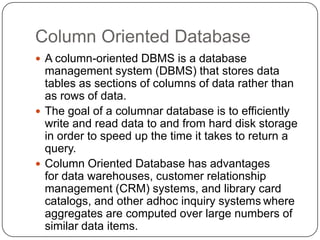Column oriented database
•Descargar como PPTX, PDF•
2 recomendaciones•3,198 vistas
Denunciar
Compartir
Denunciar
Compartir

Recomendados
Recomendados
Más contenido relacionado
La actualidad más candente
La actualidad más candente (20)
Building Lakehouses on Delta Lake with SQL Analytics Primer

Building Lakehouses on Delta Lake with SQL Analytics Primer
Data Warehousing Trends, Best Practices, and Future Outlook

Data Warehousing Trends, Best Practices, and Future Outlook
HBase Tutorial For Beginners | HBase Architecture | HBase Tutorial | Hadoop T...

HBase Tutorial For Beginners | HBase Architecture | HBase Tutorial | Hadoop T...
Similar a Column oriented database
Similar a Column oriented database (20)
Column oriented database
- 1. Column Oriented Database A column-oriented DBMS is a database management system (DBMS) that stores data tables as sections of columns of data rather than as rows of data. The goal of a columnar database is to efficiently write and read data to and from hard disk storage in order to speed up the time it takes to return a query. Column Oriented Database has advantages for data warehouses, customer relationship management (CRM) systems, and library card catalogs, and other adhoc inquiry systems where aggregates are computed over large numbers of similar data items.
- 2. Advantages of Column Database One of the main benefits of a columnar database is that data can be highly compressed. The compression permits columnar operations — like MIN, MAX, SUM, COUNT and AVG— to be performed very rapidly. Another benefit is that because a column-based DBMSs is self-indexing, it uses less disk space than a relational database management system (RDBMS) containing the same data. Column architecture doesn’t read unnecessary columns. Avoids decompression costs and perform operations faster. Use compression schemes allow us to lower our
- 3. Disadvantages of Column Database Increased Disk Seek Time Increased cost of Inserts Load time: Converting the data source into columnar format can be unbearably slow where tens or hundreds of gigabytes of data are involved. Incremental loads: Incremental loads can be performance problematic. Data compression: Some columnar systems greatly compress the source data. However, uncompressing the data to read it can slow performance.
- 4. Row Oriented Database In the context of a relational database, a row— also called a record or tuple—represents a single, implicitly structured data item in a table. In simple terms, a database table can be thought of as consisting of rows and columns or fields. Each row in a table represents a set of related data, and every row in the table has the same structure.
- 5. Advantages and Disadvantages Advantages: Row-oriented organizations are more efficient when many columns of a single row are required at the same time, and when row-size is relatively small, as the entire row can be retrieved with a single disk seek. Row-oriented organizations are more efficient when writing a new row if all of the column data is supplied at the same time as the entire row can be written with a single disk seek. Disadvantages: In a RDBMS, data values are collected and managed as individual rows and events containing related rows. A row-oriented database must read the entire record or “row” in order to access the needed attributes or column data. Queries most often end up reading significantly more data than is needed to satisfy the request and it creates very large I/O burdens.
- 6. Comparison of Columnar Database and Row Database Column-oriented organizations are more efficient when an aggregate needs to be computed over many rows but only for a notably smaller subset of all columns of data, because reading that smaller subset of data can be faster than reading all data. Column-oriented organizations are more efficient when new values of a column are supplied for all rows at once, because that column data can be written efficiently and replace old column data without touching any other columns for the rows. Row-oriented organizations are more efficient when many columns of a single row are required at the same time, and when row-size is relatively small, as the entire row can be retrieved with a single disk seek. Row-oriented organizations are more efficient when writing a new row if all of the column data is supplied at the same time, as the entire row can be written with a single disk
- 7. Example Here is an example of a simple database table with 4 columns and 3 rows [2]. ID Last First Bonus 1 Doe John 8000 2 Smith Jane 4000 3 Beck Sam 1000 In a column-oriented database management system, the data would be stored like this: 1,2,3;Doe,Smith,Beck;John,Jane,Sam;8000,400 0,1000; In a row-oriented database management system, the data would be stored like this: 1,Doe,John,8000;2,Smith,Jane,4000;3,Beck,Sa m,1000;
Notas del editor
- In a columnar database, all the column 1 values are physically together followed by all the column 2 values, etc. The data is stored in record order, so the 100th entry for column 1 and the 100th entry for column 2 belong to the same input record. This allows individual data elements, such as customer name for instance, to be accessed in columns as a group, rather than individually row-by-row.
